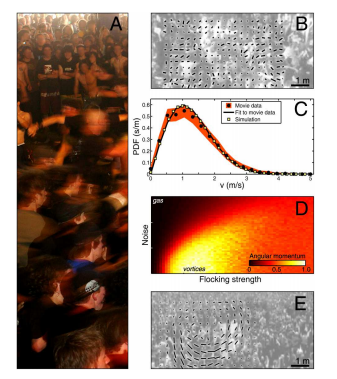Moshers, Heavy Metal and Emergent Behavior
The behavior of crowds at heavy metal concerts is surely a topic close to the hearts of many readers of the Physics arXiv Blog. In these crowds, fans often form circles called mosh pits and then run together with physical abandon, bouncing off one another with arms flaying and legs kicking.

“The collective mood is influenced by the combination of loud, fast music (130 dB, 350 beats per minute), synchronized with bright, flashing lights, and frequent intoxication,” say Jesse Silverberg and pals at Cornell University in Ithaca.
The resulting disorder may sound chaotic but Silverberg and co say it turns out to have all the properties of self-organised emergent behavior. Today, they reveal the results of their study of this phenomenon.
Silverberg and co gathered their data by examining videos of mosh pits on You Tube, such as this one and this one. These crowds contain anything from 100 to 100,000 people. After correcting for camera shake and distortions in perspective, they used particle image velicometry techniques to measure the collective motion of moshers.
What they discovered was that the speed distribution of moshers closely matches that of molecules in a 2D gas at equilibrium.
That’s curious. “Why does an inherently non-equilibrium system exhibit equilibrium characteristics?”, they ask.
To answer this, they simulated the behavior using a standard flocking simulation software in which they could vary parameters such as self-propulsion and flocking behavior. They found they could easily reproduce the actually behavior of moshers when the self-propulsion and flocking parameters were dominated by noise.
What’s more, when the flocking term begins to dominate behavior, the simulations become highly ordered revealing vortex-like patterns. That’s interesting because exactly this kind of vortex-like patterns emerge in some crowds at heavy metal concerts, like this one.
Silverberg and co say that although moshers are self-propelled and the collisions between them are dissipative, they exhibit disordered gas-like behavior. “These findings offer strong support for the analogy between mosh pits and gases,” they say.
Worth bearing in mind next you’re at a heavy metal concert.
Ref: arxiv.org/abs/1302.1886: Collective Motion of Moshers at Heavy Metal Concerts
Keep Reading
Most Popular
Large language models can do jaw-dropping things. But nobody knows exactly why.
And that's a problem. Figuring it out is one of the biggest scientific puzzles of our time and a crucial step towards controlling more powerful future models.
The problem with plug-in hybrids? Their drivers.
Plug-in hybrids are often sold as a transition to EVs, but new data from Europe shows we’re still underestimating the emissions they produce.
How scientists traced a mysterious covid case back to six toilets
When wastewater surveillance turns into a hunt for a single infected individual, the ethics get tricky.
Google DeepMind’s new generative model makes Super Mario–like games from scratch
Genie learns how to control games by watching hours and hours of video. It could help train next-gen robots too.
Stay connected
Get the latest updates from
MIT Technology Review
Discover special offers, top stories, upcoming events, and more.